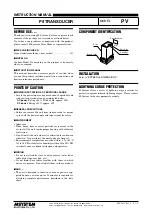
USER'S GUIDE____________________________________________________________________
186 _________________________________________________________________ M210704EN-F
Register Map
All data available via the MODBUS interface is grouped in six
contiguous blocks of registers as described in Table 35 below.
Table 35
DMT340 MODBUS Register Blocks
Address Data
Format
Description
0001…0068
32-bit IEEE float
0257…0290
16-bit signed integer
Measurement data (read-only)
0513…0517
Bit field
Status registers (read-only)
0769…0790
32-bit IEEE float
1025…1035
16-bit signed integer
Configuration settings
1281…1288
Bit field
Configuration flags
The addresses are 1-based decimal MODBUS data model addresses
without the first digit (e.g. 0xxxx, 1xxxx, 3xxxx, or 4xxxx). Subtract 1 to
get address field values used in MODBUS Protocol Data Unit (PDU).
The register map is the same for all MODBUS function codes. For
example, function codes 03 and 04 return exactly same result, as do
01 and 02.
Function codes 01 and 02 return 0 if the corresponding register has value
0x0000 and 1 if the register is non-zero. Writing with function codes 05
or 15 effectively writes value 0x0000 or 0x0001 in the register(s).
Data Encoding
All numeric values are available both in 32-bit IEEE floating point and
16-bit signed integer formats.
32-Bit Floating Point Format
Floating point values are represented in standard IEEE 32-bit floating
point format. Least-significant 16 bits of floating point numbers are
placed at the smaller MODBUS address as specified in Open MODBUS
TCP Specification, Release 1.0. This is also known as “little-endian” or
“Modicon” word order.
NOTE
Despite the specification, some MODBUS masters may expect
“big-endian” word order (most-significant word first). In such case, you
must select “word-swapped” floating point format in your MODBUS
master for DMT340 MODBUS registers.









































